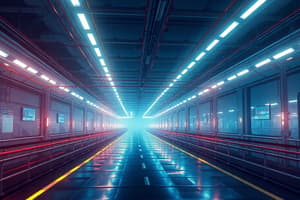Podcast
Questions and Answers
In building drainage terms, what does 'effluent' refer to?
In building drainage terms, what does 'effluent' refer to?
- Subsoil water
- Foul and soil water (correct)
- Surface water
- Treated sewer water
- Rainwater
What is the primary purpose of drainage in civil engineering and construction projects?
What is the primary purpose of drainage in civil engineering and construction projects?
- To maintain a stable water table
- To create artificial water bodies
- To promote soil erosion
- To avoid flooding and water damage (correct)
What does the Building Regulations (2010): Part N emphasize about above-ground drainage systems?
What does the Building Regulations (2010): Part N emphasize about above-ground drainage systems?
- Promoting the aesthetic appeal of drain pipes
- Protecting the health of building occupants (correct)
- Maximizing noise from discharges
- Minimizing the speed of discharges
What is the main purpose of a soil and waste pipe system in a building?
What is the main purpose of a soil and waste pipe system in a building?
What is the significance of conveying effluent by drains to sewers in building drainage?
What is the significance of conveying effluent by drains to sewers in building drainage?
Which of the following is NOT included in the types of drainage systems discussed in the text?
Which of the following is NOT included in the types of drainage systems discussed in the text?
What should the ABOVE-GROUND DRAINAGE SYSTEM consist of?
What should the ABOVE-GROUND DRAINAGE SYSTEM consist of?
What is the purpose of the vent pipe in the drainage system?
What is the purpose of the vent pipe in the drainage system?
What is the main disadvantage of the single stack system compared to the two-pipe system?
What is the main disadvantage of the single stack system compared to the two-pipe system?
What is the essential part of the construction of a building, according to the text?
What is the essential part of the construction of a building, according to the text?
What are the risks associated with an unsound and leaking drain?
What are the risks associated with an unsound and leaking drain?
What does a separate drainage system involve?
What does a separate drainage system involve?
What is the primary advantage of a combined drainage system over a separate system?
What is the primary advantage of a combined drainage system over a separate system?
What should be kept at a minimum in the layout of the drainage system?
What should be kept at a minimum in the layout of the drainage system?
What is the purpose of a straight line pipe in the drainage system?
What is the purpose of a straight line pipe in the drainage system?
Which type of drain involves only one drain for both foul and surface water?
Which type of drain involves only one drain for both foul and surface water?
What is the term for the process in which water pools in large bodies such as oceans, seas, and lakes?
What is the term for the process in which water pools in large bodies such as oceans, seas, and lakes?
Which process involves water vapor (gas state) in the air turning into liquid state (water) to form clouds in the sky?
Which process involves water vapor (gas state) in the air turning into liquid state (water) to form clouds in the sky?
What is the term for the process in which water (liquid state) becomes water vapor (gas state) from the surface of oceans, lakes, and snow fields?
What is the term for the process in which water (liquid state) becomes water vapor (gas state) from the surface of oceans, lakes, and snow fields?
Which process involves water (in the form of rain, snow, sleet, or hail) falling from clouds in the sky?
Which process involves water (in the form of rain, snow, sleet, or hail) falling from clouds in the sky?
What is the term for subsurface and surface water runoff that flows in underground streams, drains, or sewers?
What is the term for subsurface and surface water runoff that flows in underground streams, drains, or sewers?
In the context of the hydrological cycle, what refers to the process in which some water within plants evaporates into the atmosphere?
In the context of the hydrological cycle, what refers to the process in which some water within plants evaporates into the atmosphere?
What refers to the processes used to make water more acceptable for a desired end-use?
What refers to the processes used to make water more acceptable for a desired end-use?
Which source accounts for about 71% of the Earth's surface water?
Which source accounts for about 71% of the Earth's surface water?
What percentage of the Earth's water resources do the oceans account for?
What percentage of the Earth's water resources do the oceans account for?
How much of Earth's water is saline (oceans)?
How much of Earth's water is saline (oceans)?
What is the term for storage accumulation of water in large bodies such as oceans, seas, and lakes?
What is the term for storage accumulation of water in large bodies such as oceans, seas, and lakes?
Which type of water accounts for about 0.9% of Earth's freshwater?
Which type of water accounts for about 0.9% of Earth's freshwater?
Flashcards are hidden until you start studying
Study Notes
Building Drainage Terms
- Effluent: Wastewater discharged from a building, including sewage and other waste.
Purpose of Drainage
- The primary purpose of drainage in building projects is to remove wastewater and rainwater efficiently and safely.
Building Regulations (2010): Part N
- Above-ground drainage systems: Emphasizes the importance of proper design and installation to prevent leaks, blockages, and odours.
Soil and Waste Pipe System
- Carries wastewater from fixtures like toilets, sinks, and baths to the main sewer system.
Conveying Effluent to Sewers
- Ensures that wastewater is transported away from buildings efficiently and safely, preventing contamination and health hazards.
Drainage System Types
- Not included: Specific mention of all drainage system types, such as single stack, two-pipe, and combined drainage.
Above-ground Drainage System
- Should consist of:
- Soil and waste pipes
- Vent pipes
- Traps
- Access points for maintenance
Vent Pipes
- Provide ventilation for the drainage system, preventing pressure buildup and siphoning of water from traps.
Single Stack vs. Two-Pipe System
- Disadvantage of single stack: Potential for cross-contamination between waste and vent pipes.
Essential Part of Building Construction
- Drainage system is a vital component of any building; its proper design and installation are crucial for health and safety.
Risks of Unsound and Leaking Drains
- Potential for:
- Water damage to the building
- Health hazards due to sewage backup
- Unpleasant odours
Separate Drainage System
- Involves separate pipes for foul water (sewage) and surface water (rainwater).
Combined Drainage System
- Advantage: Single pipe system, less complex and cost-effective compared to separate systems.
Drainage System Layout
- Aim to minimize sharp bends and long runs in the piping for efficient flow.
Straight Line Pipe
- Facilitates smooth flow of wastewater through the drainage system.
Combined Drain
- Single drain for both foul and surface water, suitable for smaller buildings.
Water Pooling
- Term: Collection
Water Vapor to Liquid
- Process: Condensation
Liquid to Water Vapor
- Process: Evaporation
Water Falling from Clouds
- Process: Precipitation
Subsurface and Surface Water Runoff
- Term: Runoff
Water Evaporation from Plants
- Process: Transpiration
Water Treatment Processes
- Term: Water Treatment
Earth's Surface Water
- Main source: Oceans
Earth's Water Resources
- Ocean's contribution: 96.5%
Saline Water
- Percentage: 96.5%
Storage Accumulation of Water
- Term: Collection
Earth's Freshwater
- Type of water: Groundwater
Groundwater
- Percentage of Earth's freshwater: 0.9%
Studying That Suits You
Use AI to generate personalized quizzes and flashcards to suit your learning preferences.




